Part of the IAGenWeb Project
|
The Globe Gazette Mason City, Cerro Gordo County, Iowa October 26, 2008
by Kristin Buehner
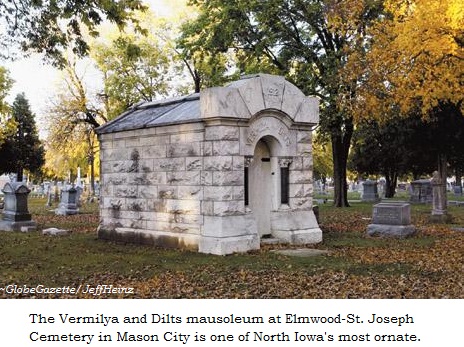
Making a social statement is a part of life that continues after death, visitors to North Iowa cemeteries will discover.
Cemeteries are places of pilgrimage and prayer, research areas for genealogists and destinations for joggers, walkers and those just out for Sunday drives.
But they’re also living museums of tombstone and monumental art.
“They’re really works of art, a lasting memorial for the family or for successful people,” said Robert Fells, external chief operation officer for the International Cemetery, Cremation and Funeral Association in Sterling, Va. Some are private and some are public, containing multiple burial chambers to be sold on an as-needed basis.
Individual tombs or crypts scattered around a cemetery are junior members of the mausoleum family; and columbariums, containing niches to hold cremated remains, are among the newest additions to many burial grounds. But it tends to be the big boys — mausoleums built to impress — that speak loudest.
At Mason City’s Elmwood-St. Joseph Cemetery, a stone mausoleum built in 1908 for William Smith of Marshalltown and members of his family resembles a little house, with double metal doors, columns etched on either side of the doors and evergreen trees flanking the front.
The inhabitants are William Smith (buried in 1908), Inez Elizabeth Mills (1918), Elizabeth C. Smith (1928), Charles E. Smith (1932), William Smith and Dott Smith (1976).
Thomas G. Emsley [born in 1844 and a Civil War soldier], who died in 1904, was founder, in 1875, and first president of City National Bank in Mason City. His widow, Mary Ann (Church) Emsley Adams [born in 1840], a businesswoman, took over his job as bank president when he died. She later married Charles A. Adams [born in 1840], a Mason City court reporter. Mary Emsley Adams worked to establish a free public library in Mason City and was an active suffragette. She died [March 21] 1931.
Mabel Emsley Gale [born in 1868], who died [July 27] 1904, was the daughter of Thomas and Mary Ann (Church) Emsley. She married Absalom H. Gale, a vice president of City National Bank, who had an interest in one of the cement plants and owned valuable realty in Mason City and the surrounding area. A.H. Gale, [born in February of 1863], as he was known, also served as a state senator. He died in 1923.
Cecil Emsley Gale [born in July of 1895], son of A. H. and Mabel Emsley Gale, died [February 5] 1933 at the age of 38. Blind since birth, he was said to be an excellent pianist.
Another notable rough-hewn stone mausoleum (pictured above) was built in 1912 for members of the George Vermilya family. George Vermilya, one of the pioneers of Mason City, is buried elsewhere in the cemetery. [George was born in 1822 and died in June of 1914.]
The mausoleum houses his family, including his wife Helen [K. (Miller)] Vermilya [born in 1832], who died [July 12] 1898, and their four children: daughter Lida, or Lidya [born in 1869], who died in 1892; daughter Grace M. (Vermilya) Dilts [born January 13, 1869], [died February 27, 1920] 1924; son Theron Vermilya [born in 1863], owner of the VERMILYA Cafe in Mason City, who died [January 13] 1933, and his wife, [Anna] Belle [(FUNK)] Vermilya [born October 21, 1871], who died [January 14] 1949; and daughter Jessie Vermilya DECKER [born in 1863 and died February 7, 1943] and her husband, Frank H. Decker, both of whom died in 1943. [Cemetery transcription gives Frank's death date as February 25, 1933. Also interred in the mausoleum is "Infant Dilts", born and died on August 5, 1900.]
Dr. Clarence W. Swale, who died in 1915, and his wife Lillian (Garmidge) Swale, 1921, and a son, Clarence W. Swale, Jr., who died in 1907, are buried in identical crypts, built in 1915. Dr. Swale was a distinguished surgeon and gynecologist, educated at home and in London, Berlin, Paris and Copenhagen. One of the founders and president of City Park Hospital, he also served as a Mason City alderman.
The best-known mausoleum at Elmwood, also built in 1915, is the granite structure built for Minnie Melson by her husband, Joshua G. Melson. Four years older than her husband, Minnie was a popular Mason City school teacher. When she died at age 54, her husband hired prairie school architect Barry Byrne to design a prairie style mausoleum in the same vein as the home Melson had built for her in Rock Crest, called “the Castle.” Built of rough-hewn stone, the structure is massive but simple. It has a door and a window, through which a bench inside the structure can be viewed.
Joshua Melson was a Mason City building contractor-developer, who purchased and platted the River Heights area and helped develop Rock Glen-Rock Crest. He built Lincoln School, the Congregational Church and the first footbridge over Willow Creek. Melson was among the first Mason City residents to own an automobile and the first to own an airplane. He died in 1946 in Los Angeles at the age of 81.
Minnie is laid to rest under the floor of the meditation/prayer room inside of the mausoleum. Joshua and his second wife, Julia, who died in 1956, are buried under the flower bed outside the Melson mausoleum.
In Forest City, the mausoleum Dr. William Steele, a dentist, built for his wife, Etta, is in Oakland Cemetery.
Etta Maud (Colyer) Steele [born in 1854] died [June 26] 1899. Dr. Steele remarried and moved to Minnesota and is buried elsewhere.
Ruth Leibrand, a historian and charter member of the Lime Creek Genealogical Society, collected a May 31, 1900, article from The Winnebago Summit that tells us, among other things, that the structure’s base is marble and its walls, of Bedford, Inc., stone. “The roof consists of two solid marble slabs 4 inches thick,” according to the report. “ The floor is one solid marble slab 4 inches thick. The front leading to the door is a Bedford stone walk 8 feet long and 3 feet wide in one solid piece. “The inside door is one solid marble slab two inches thick. The outer door is of maleable iron punch rail.”
Thomas M. Atherton, interred in a mausoleum in Osage City Cemetery, was born in 1829 (sic, April 12, 1827) [Kingston] Pennsylvania, came to Mitchell County in 1860, and founded the Mitchell County Press (now the Press-News) in 1865 in the city of West Mitchell. Atherton moved the Press to Osage on May 20, 1869, according to the A.T. Andreas Illustrated Historical Atlas of the State of Iowa, 1875. Atherton was West Mitchell’s first postmaster, and served as superintendent of the Mitchell county schools. The doors contain especially fine decorative metal work.
[Thomas died February 25, 1940. Also interred in the mausolleum are Elizabeth J. (Gilmore) Atherton (1830 - 1900), Thomas' wife; son Thomas Mitchell Atherton Jr. (1871 - 1929).]
Back at Elmwood-St. Joseph, a simple vertical two-person crypt built in 1962 is the final resting place of Albert L. "Al" Lake [born July 22, 1882] and his wife Clara (Hanson) Lake [born August 21, 1887], who died [November 11] 1963. Albert Lake, a Mason City contractor, built many businesses, including the Clear Lake Fish Hatchery and Radio Chapel in Mason City, and more than 150 houses. A native of Norway, Lake fought in World War I. He died [January 25] 1962 at the age of 82. Clara Lake was a Mason City elementary school teacher.
The most recent mausoleum is a small single-vault structure built in 2004 for Martha (Thomson) Barclay. A widely-known English instructor at North Iowa Area Community College, gourmet cook, world traveler, public speaker and frequent hostess, she died at the age of 83.
In Charles City, a modern stone mausoleum at Sunnyside Memory Gardens is an example of a community mausoleum. It includes burial space for 64, most of which are still open. The earliest burial date is 1983.
Dick Johnson contributed to this article.
Transcription by Sharon R. Becker, March of 2017 |
Return to Elmwood-St. Joseph Cemetery Page
Return to Cerro Gordo Home Page
© Copyright 1996-
Cerro Gordo Co. IAGenWeb Project
All rights Reserved.



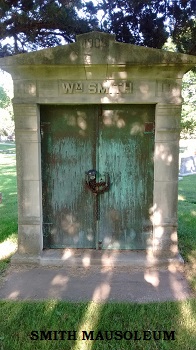 At the top of the burial heap are mausoleums, large, classically inspired and costly tombs commissioned by some as status symbols and by others because of an aversion to being planted six feet under.
The word comes from the tomb King Mausolus of Turkey, one of the Seven Wonders of the Ancient World.
At the top of the burial heap are mausoleums, large, classically inspired and costly tombs commissioned by some as status symbols and by others because of an aversion to being planted six feet under.
The word comes from the tomb King Mausolus of Turkey, one of the Seven Wonders of the Ancient World. Nearby, an elaborate mausoleum of brick, stone and marble with granite columns, Corinthian ornamentation and a door with iron gate was built in 1910 for members of the Gale-Emsley families of Mason City.
Nearby, an elaborate mausoleum of brick, stone and marble with granite columns, Corinthian ornamentation and a door with iron gate was built in 1910 for members of the Gale-Emsley families of Mason City.
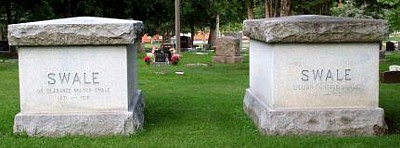

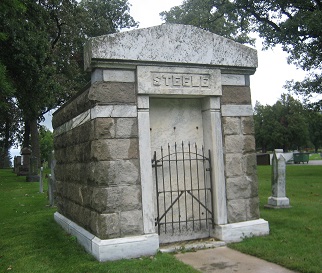
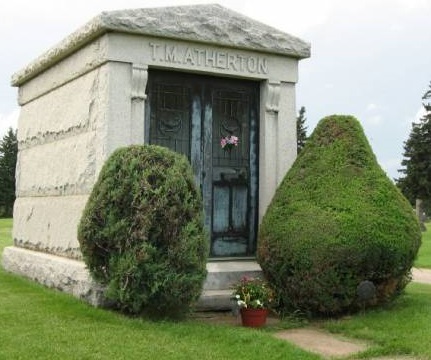


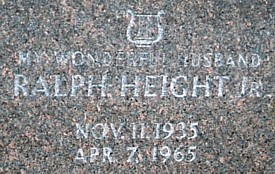 A graceful and modern stone crypt and Elmwood-St. Joseph, set at an angle so as to be highly visible, in memory of Ralph Height, Jr., a talented Mason City organist and director of music at St. James Lutheran Church when he died. He was killed at the age of 29 in a car accident.
A graceful and modern stone crypt and Elmwood-St. Joseph, set at an angle so as to be highly visible, in memory of Ralph Height, Jr., a talented Mason City organist and director of music at St. James Lutheran Church when he died. He was killed at the age of 29 in a car accident.